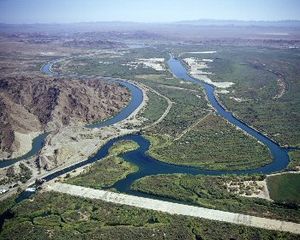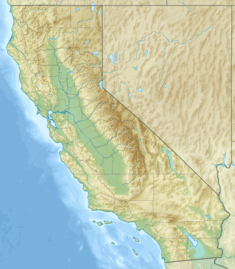Laguna Diversion Dam facts for kids
Quick facts for kids Laguna Diversion Dam |
|
|---|---|

Overhead of dam facing north
|
|
|
Location of Laguna Diversion Dam in USA California
|
|
| Location | Imperial County, California / Yuma County, Arizona, USA |
| Coordinates | 32°49′22″N 114°29′39″W / 32.82278°N 114.49417°W |
| Construction began | 1903 |
| Opening date | 1905 |
| Operator(s) | U.S. Bureau of Reclamation |
| Dam and spillways | |
| Type of dam | Rock-fill weir, concrete surface |
| Impounds | Colorado River |
| Height | 43 feet (13 m) |
| Length | 4,780 feet (1,460 m) |
| Spillway type | Controlled service |
The Laguna Diversion Dam is a special kind of dam called a diversion dam. It's built on the Colorado River and helps control where the river's water goes. You can find it about 13 miles northeast of Winterhaven, California and Yuma, Arizona. This dam was built a long time ago, between 1903 and 1905. It was actually the very first dam ever built on the Colorado River! After it was built, boats could no longer travel far north on the river.
Contents
Building the Laguna Dam
Starting the Yuma Project
After the U.S. Congress passed a law called the Reclamation Act in 1902, the U.S. Bureau of Reclamation started building the Laguna Dam. This was part of a bigger plan called the Yuma Project. The Yuma Project was the first time the U.S. Reclamation Service worked on the lower part of the Colorado River. It included the Laguna Diversion Dam, a pumping station, and many canals to move water.
Construction Challenges
On July 6, 1905, a company called J. G. White and Company won the contract to build the dam. They started working less than two weeks later. Building the dam was tricky because of two main problems:
- Getting cement: Cement had to be brought to Yuma by train. From there, it had to travel to the dam site by wagons or steamboat. This made deliveries slow and difficult.
- Poor rock quality: The rocks found nearby were not strong enough. About half of the rock they found couldn't be used for building. This caused many delays.
Even though the company got extra money to deal with the rock problems, they still couldn't finish on time. So, in early 1907, the Bureau of Reclamation took over the construction themselves.
Solving the Problems
The Bureau of Reclamation found ways to fix the construction issues:
- Cement delivery: They built a levee (a raised bank) on the California side of the dam. On top of this levee, they built a rail-line by March 1908. They also worked with the Southern Pacific Railroad to deliver cement directly to the dam site.
- Rock problem: They raised the upstream and downstream cofferdams (temporary barriers) using waste rock. They then put rail lines on top of these barriers. This allowed them to bring rock-fill to the dam much faster.
By December 1908, a way for water to go around the dam was finished. Workers then started pouring the rock-fill. The dam's foundation was made of three large concrete walls. These walls were supported by 6-inch wooden poles. Rock-fill was placed between and around these walls to make the dam strong. The California side of the dam had three iron gates to control water flow, while the Arizona side had one.
Workers and Design
Most of the workers who built the dam were Mexican-American. Some Native American Indians also worked there. Skilled white workers usually worked during the cooler months.
The Laguna Dam was quite unusual for its time because of its design and size. It was only 43 feet (13 meters) tall, and almost two-thirds of it was built below the riverbed! This meant the dam only raised the river's water level by about ten feet.
Later Use
Between 1923 and 1924, some changes were made to the dam's downstream part. Later, a new dam called the Imperial Dam was built about 5 miles upstream. After the Imperial Dam was finished, the Laguna Diversion Dam was no longer needed for its main purpose. Its water outlets on the California side were closed on June 23, 1948. Today, the Laguna Dam mostly helps control the water flowing out of the Imperial Dam. It doesn't usually hold back a large amount of water anymore.
Swastika Design
The Laguna Dam has many swastikas carved into it, which is why it was sometimes called the "Swastika Dam." It's important to know that these swastikas were put there before Adolf Hitler and the Nazis used the symbol. At the time the dam was built, the swastika was an ancient symbol of good luck and well-being in many cultures around the world. It had nothing to do with racism or the Nazi party's ideas that came much later.
Fish Species
Many types of fish can be found near the Laguna Dam:
- Largemouth Bass
- Striped Bass
- Crappie
- Bullhead catfish
- Catfish (Channel)
- Catfish (Flathead)
- Tilapia
- Redear Sunfish
- Green Sunfish
- Bluegill Sunfish
- Mullet
- Carp
- Bullfrogs
Images for kids



